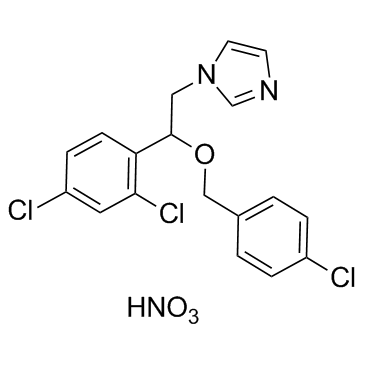Econazole (nitrate)

Econazole (nitrate) structure
|
Common Name | Econazole (nitrate) | ||
|---|---|---|---|---|
| CAS Number | 24169-02-6 | Molecular Weight | 444.696 | |
| Density | N/A | Boiling Point | N/A | |
| Molecular Formula | C18H16Cl3N3O4 | Melting Point | 162°C | |
| MSDS | USA | Flash Point | N/A | |
| Symbol |

GHS07 |
Signal Word | Warning | |
|
Selective extraction of antimycotic drugs from sludge samples using matrix solid-phase dispersion followed by on-line clean-up.
Anal. Bioanal. Chem 407(3) , 907-17, (2015) An effective and selective, modular sample preparation method for the extraction of eight antimycotic drugs, belonging to three different chemical classes, from digested sludge samples is proposed. To this end, matrix solid-phase dispersion (MSPD) was on-line... |
|
|
Azole antifungals are potent inhibitors of cytochrome P450 mono-oxygenases and bacterial growth in mycobacteria and streptomycetes.
Microbiology 148 , 2937-49, (2002) The genome sequence of Mycobacterium tuberculosis has revealed the presence of 20 different cytochrome P450 mono-oxygenases (P450s) within this organism, and subsequent genome sequences of other mycobacteria and of Streptomyces coelicolor have indicated that ... |
|
|
Econazole: a review of its antifungal activity and therapeutic efficacy.
Drugs 16 , 177-201, (1978) Econazole1 is a recently introduced imidazole antifungal agent which is very closely related structurally to another imidazole derivative, miconazole. For local application the nitrate salt of econazole is used, while in preliminary investigations of systemic... |
|
|
Inhibition of Ca2+ transport pathways in thymic lymphocytes by econazole, miconazole, and SKF 96365 M. J. Mason, B. Mayer, et al.
Am. J. Physiol. Cell Physiol. 264 , C654-C662, (1993)
|
|
|
Antifungal agents: mode of action, mechanisms of resistance, and correlation of these mechanisms with bacterial resistance.
Clin. Microbiol. Reviews 12 , 501-17, (1999) The increased use of antibacterial and antifungal agents in recent years has resulted in the development of resistance to these drugs. The significant clinical implication of resistance has led to heightened interest in the study of antimicrobial resistance f... |
|
|
Bactericidal and inhibitory effects of azole antifungal compounds on Mycobacterium smegmatis.
FEMS Microbiol. Lett. 192 , 159-162, (2000) Azole antifungals are central to therapy and act by inhibiting a cytochrome P450, sterol 14-demethylase and blocking normal sterol synthesis. Our recent identification of a mycobacterial sterol biosynthetic pathway led us to probe the efficacy of a range of t... |